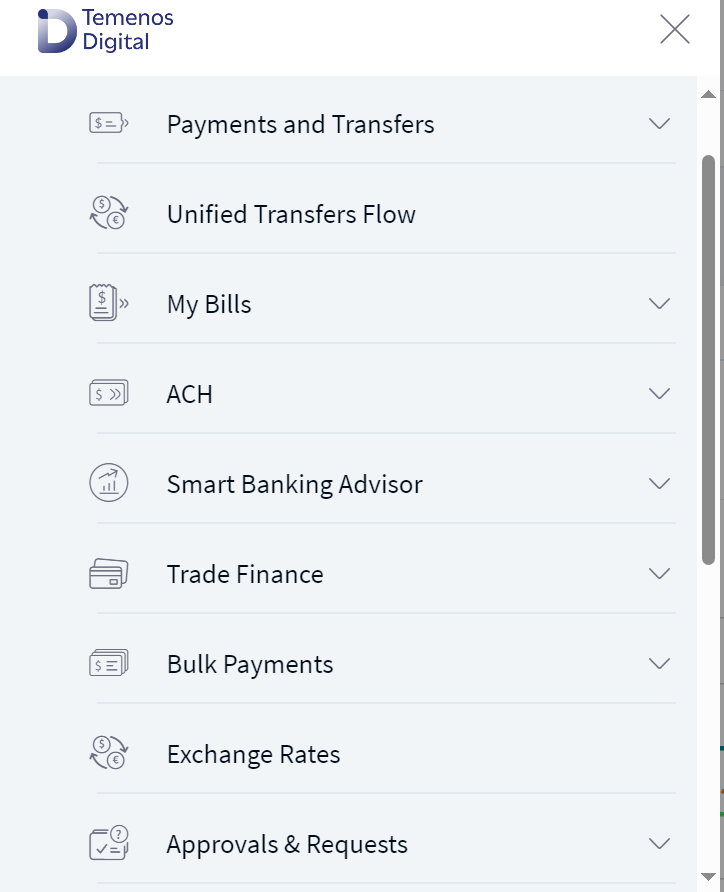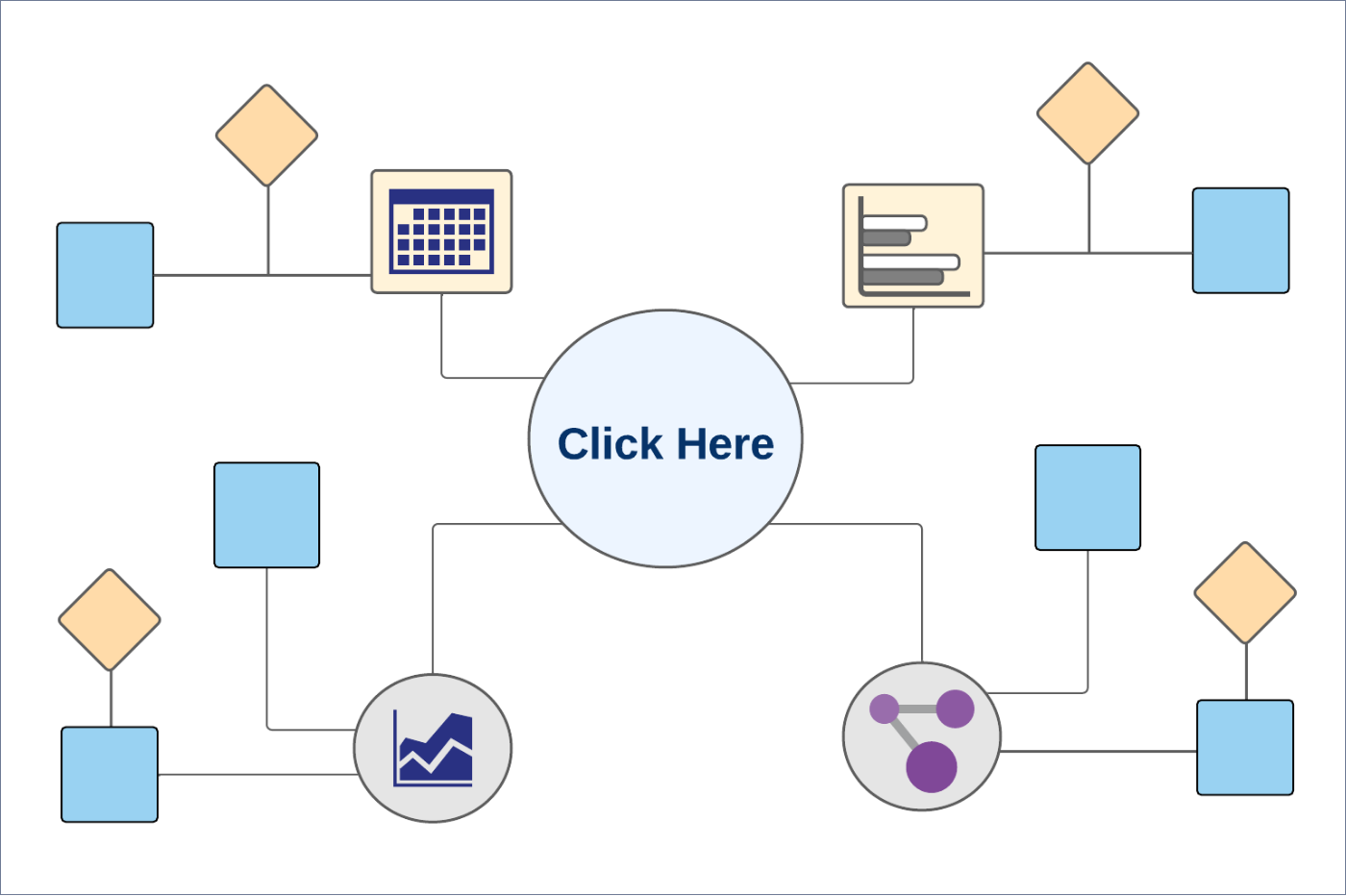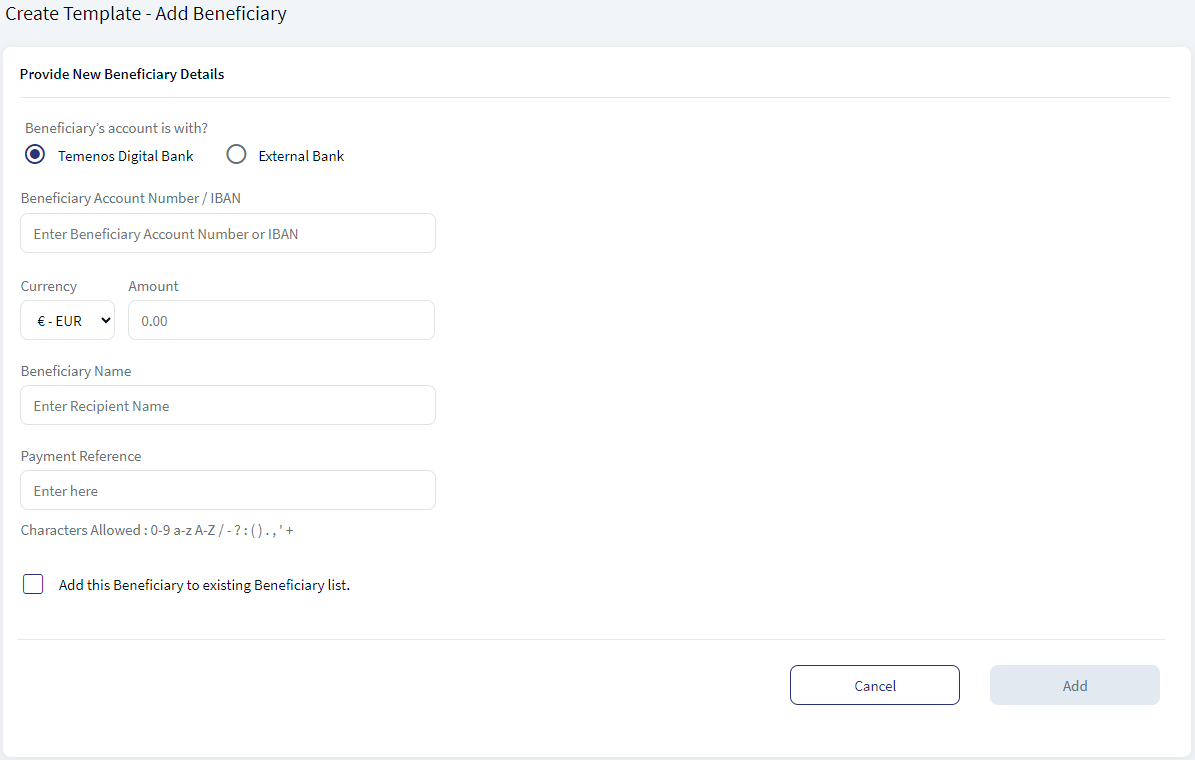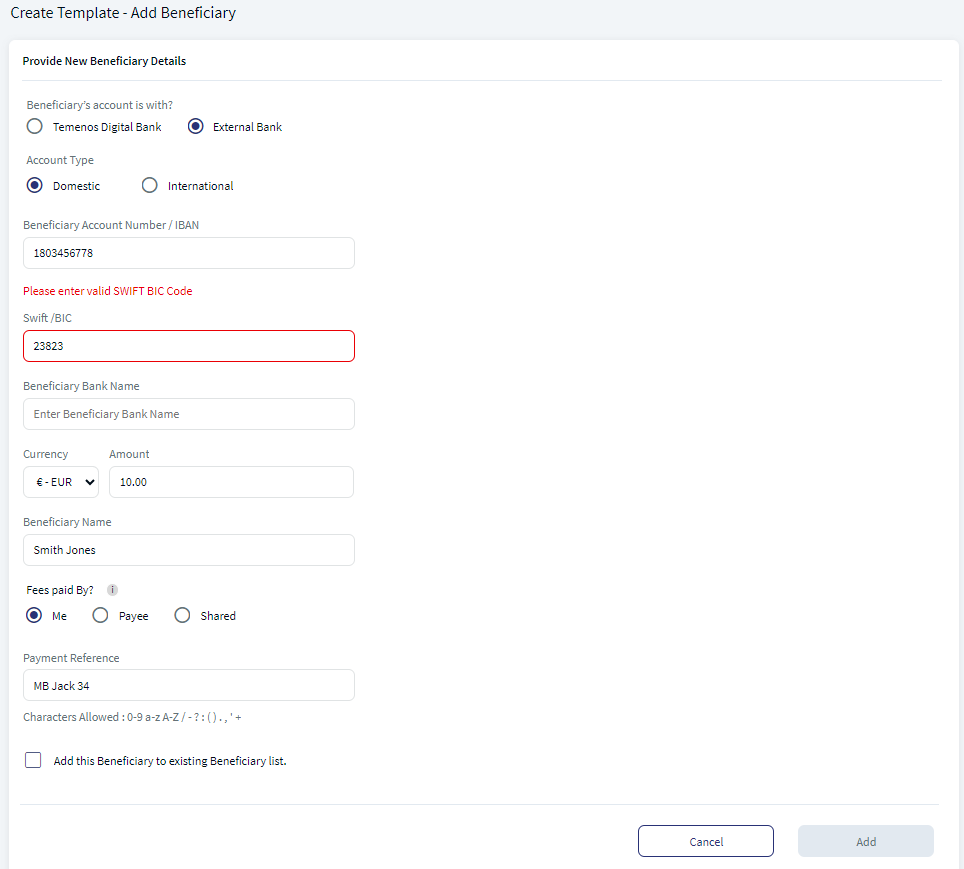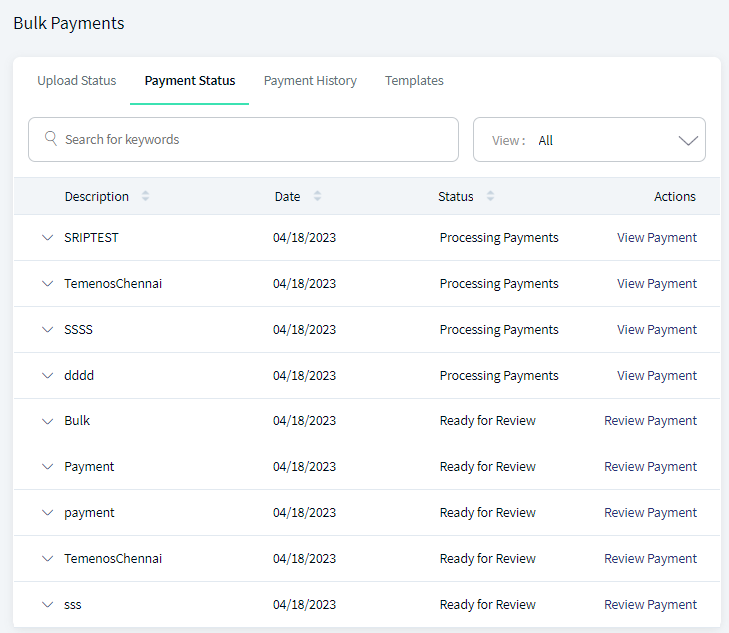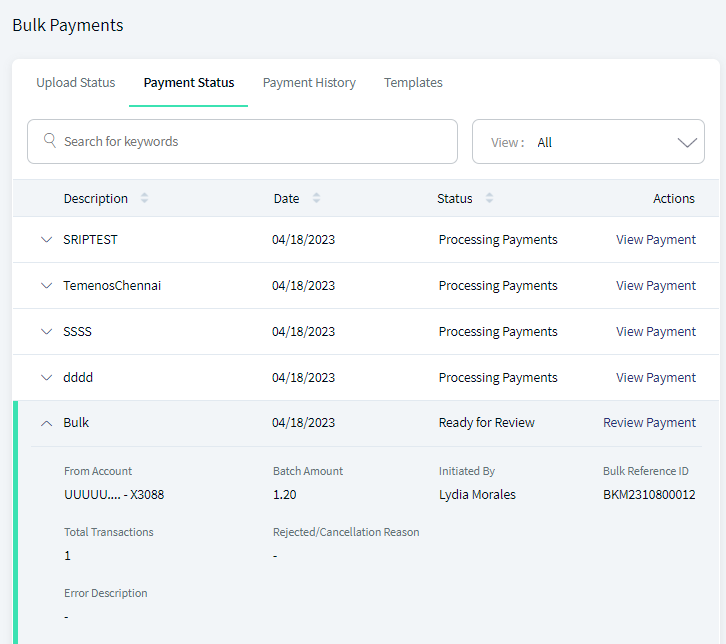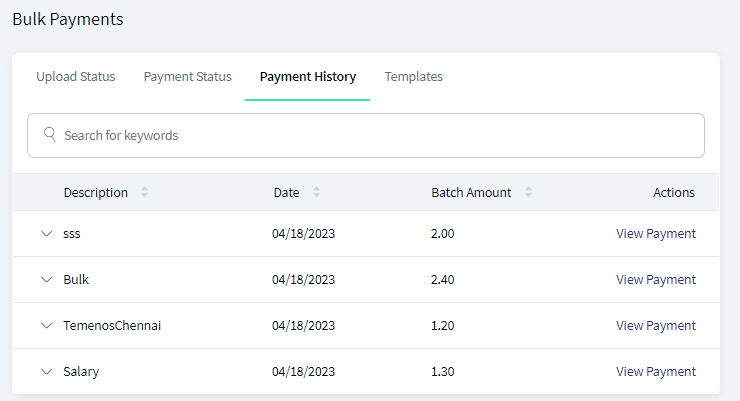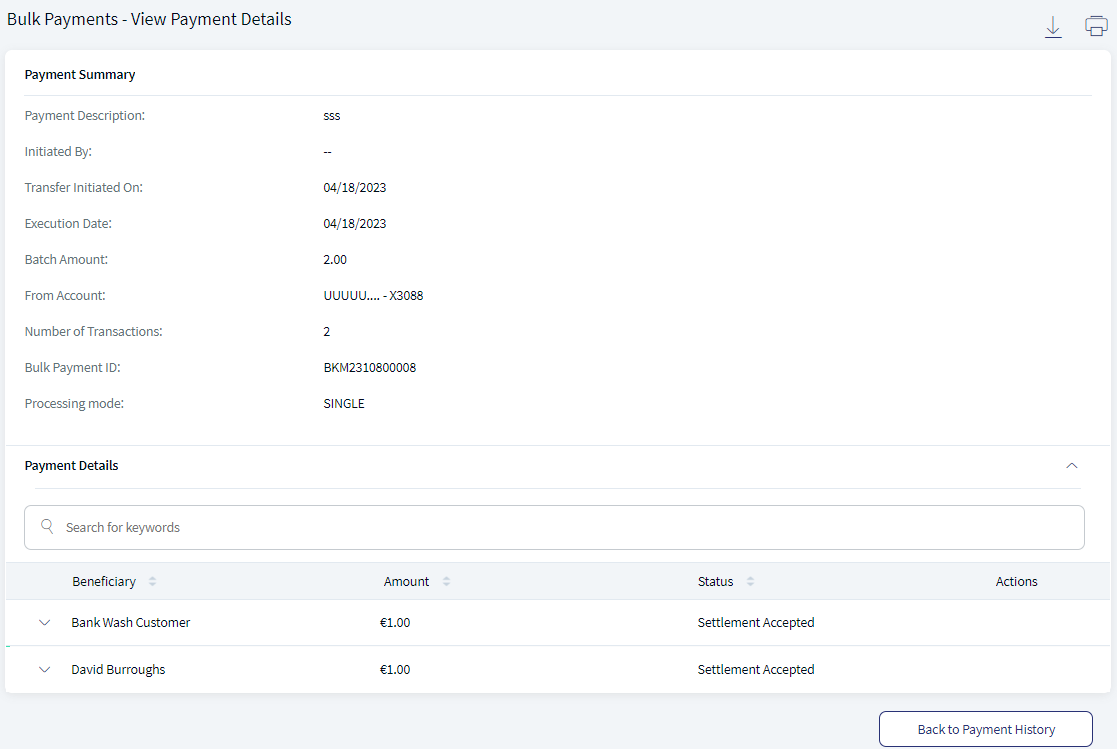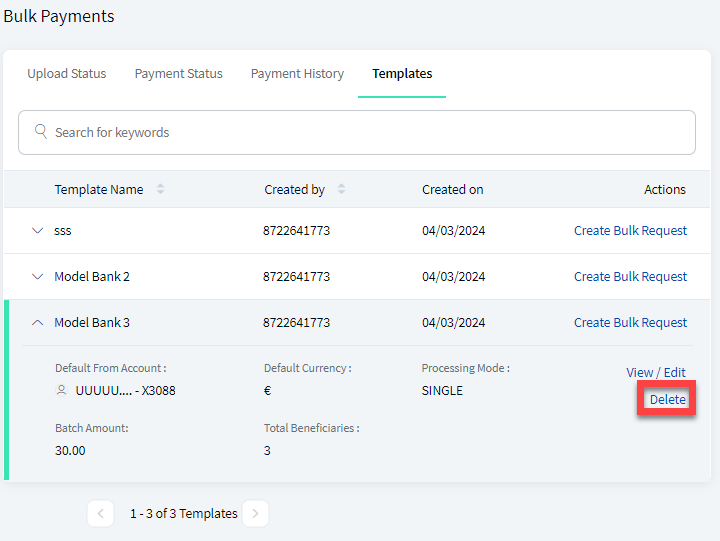Bulk Payments
The Bulk Payments is a system that allows to make multiple payments to a bulk list. The bulk list of beneficiary payments the bank intends to pay from a single account.
A business user with the required permissions can initiate Bulk Payments by uploading a file (.csv or .xml) or through online template. Using this option, multiple payment details are uploaded in a single instance. This feature is applicable only to Web Channel and integrated with Transact directly. The request is created in Transact and the Transact application processes the payments.
The bulk payment feature supports the following functions and abilities:
- Upload bulk payment files in both xml (PAIN.001.03) and csv (Transact Proprietary format) files to create request.
- Create bulk payment request via online templates instead of file upload.
- Review the bulk payment request done via file upload or template.
- Submit the bulk payment request created via file upload or template.
- View, edit, and delete the uploaded bulk payment templates.
- Track the status of bulk payment request pending for authorization.
- Review the rejected bulk payment request and re-submit for authorization.
- Track the status of payment processing post authorization.
- Maintain list of bulk payment templates for reuse.
- The supervisor approving the bulk payments can view the list of bulk payment request pending for authorization and choose to Approve / Reject as required. Post authorization, the bulk payment request is initiated for processing the payment.
- Supports approval matrix.
- Supports limit validation.
- View the status of the requests submitted for processing.
- Supports two types of batch processing:
- Single – This mode is used for payroll / bonus processing (Single Debit and Multiple credits).
- Multiple – This mode is used for mass payments like vendor payments (each transaction is processed separately).
The permissions for the business user are managed in the spotlight application. Navigate Customers Management > Customer > Search for customer > Features and Actions > Bulk Payment Template. Edit the available actions based o the criteria.
The following is the list of available actions:
- Submit a bulk request (Single and Multiple)
- Create, edit, view, and delete request
- Adding external bank details(domestic and International)
- Create and edit payment order
Multi Entity Support: Customers can view the dashboard, perform transfers, or view any request summary and submit requests against the entity associated with the customer during login. The feature is enhanced with Experience APIs to retrieve and post based on the Entity ID of the signed-in user.
- The Entity ID selected by the signed-in user flows through the application through the respective Experience API.
- For all fetch (GET) API calls, the system retrieves the results based on the Entity ID of the signed-in user.
- For all add/update/delete calls, the system passes and posts requests against the Entity ID of the signed-in user.
The feature supports the following modules:
| Authentication | Dashboard | Account Overview |
| Credit Card overview | Cheque Management | Card Management |
| Statements | Dispute Transactions | Service Requests |
| PFM | Savings Pot | Account Settings |
| Sign In Settings | Profile Settings | Consent Management |
| Unified Transfers | Manage Transfers | Manage Beneficiaries |
| Bulk Payments | Bill Payments | Foreign Exchange |
| Portfolio Management | WealthOrder | Approval Matrix |
- The accounts are segregated by customer ID at all relevant places in the application during transfers and other flows and icons against each account indicates the type of account.
- The uploads to create request is done through file upload and through template.
- Appropriate Permissions are required for single and multi processing modes for the user to proceed with the journey. In case, if either of the processing mode permission is not there, the user cannot proceed with corresponding journey.
- The approvals and limit values are different for single and multi processing modes. If the approvals and limit values exceeds than configured value the user cannot proceed with corresponding journey. These values are configured in Spotlight application.
Web Channel menu path: Side menu > Bulk Payments > Click any of the following links: Upload Requests, Payment Status, Payment History, Templates, Upload File, and Create New Template. The application displays the relevant screen.
The Bulk Payments form contains four tabs and links to activities on the right-side bar:
- Upload Status
- Payment Status
- Payment History
- Templates
- Create New Template
- Upload File and Make Bulk Payment
- Download CSV Template
Business Process Diagram - Bulk Payments
Create New Template
Use the feature to create new templates for bulk payments by entering primary and beneficiary details.
Web Channel menu path:
- Side menu > Bulk Payments > Create New Template.
- Right-side bar > Create New Template
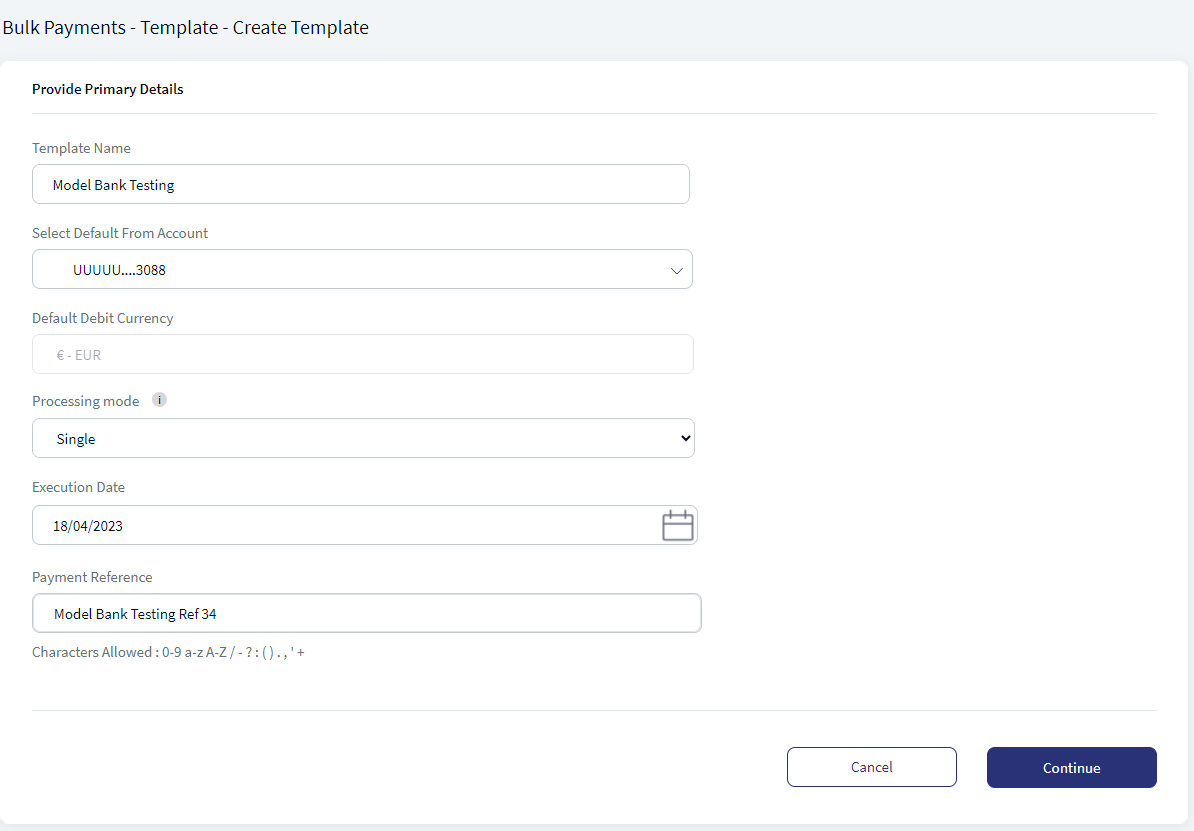
The application displays the create template screen.
To create a bulk payment template, follow these steps:
- Provide Primary Details
- Template Name. Enter a template name to identify the template. The template name must be unique, and the maximum length of the template name can be 50 characters.
- Select Default From Account. Only eligible accounts are displayed in the list. Select the debit account from the list. The display of the accounts in the drop-down list depends on the permission given to the user. For a user with access to personal accounts and multiple Customer IDs, the accounts except the account selected in the From field are displayed grouped by the personal accounts followed by Customer ID names and their respective accounts. For a user with access to multiple Customer IDs, the accounts except the account selected in the From field are displayed grouped by Customer IDs.
- Select Default Debit Currency. Currencies of the selected account are displayed here.
- Processing Mode. Select from the list - Single or Multiple.
- Single. The bulk payment will be processed with a single debit followed by multiple credits. This mode is mainly selected for salary processing, bonus payment, and more.
- Multiple. The bulk payment will be processed, where each transaction is processed separately; for every credit there is a corresponding debit entry in the account. This mode is mainly selected for processing vendor payments.You can select the currency code based on the processing mode while adding a new payment detail:
- For single processing mode the currency code is defaulted to debit account currency and is disabled. You cannot change the currency code.
- For Multi-Processing mode, the currency code is defaulted to debit account currency and is enabled, you can change the currency code, if required.
- Appropriate Permissions are required for single and multi processing modes for the user to proceed with the journey. In case, if either of the processing mode permission is not there, the user cannot proceed with corresponding journey.
- The approvals and limit values are different for single and multi processing modes. If the limit values exceeds than configured value the user cannot proceed with corresponding journey. These values are configured in Spotlight application.
- Execution Date. Select the payment initiation date from the calendar or enter the date in DD/MM/YYYY format.
- Payment Reference. Enter the payment description for reference.
Only 0-9 a-z A-Z / - ? : ( ) . , ' + characters allowed are enter the field.
- Click Continue to proceed to the add beneficiaries screen.
Cancel the process at any time. The changes are not saved.
- Add Beneficiaries. Add beneficiaries manually or select from the existing beneficiaries list maintained by the user. See notes on beneficiaries for more information.
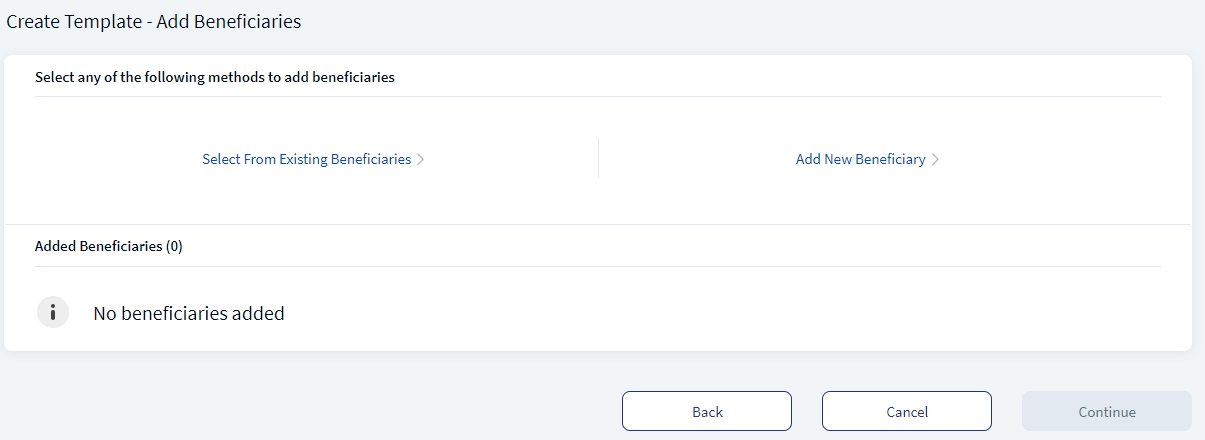
Bulk Payments - Add Beneficiaries - Select from Existing Beneficiaries. Add the existing beneficiaries. Follow these steps:
- Click Select from Existing Beneficiaries.

Bulk Payments - Add Existing Beneficiary - The select beneficiaries page appears with the list of saved beneficiaries with the following details: Beneficiary Name, Bank Name, and Payment Method.
- Click the down arrow besides each beneficiary record to view the additional details such as Account Number / IBAN, SWIFT / BIC, and Nick Name depending on the payment method (internal, domestic, and international).
- Perform any of the following actions:
- Search for specific beneficiaries using the search bar.
- Sort the list using the sort icon. By default, the list is sorted by the beneficiary name.
- Turn on / off to view only the selected recipients to review before adding them to the template.
- This option is turned off by default.
- It cannot be toggled if there are no recipients to select.
- On turning on, only the selected beneficiaries are shown while maintaining the same sort order applied on the page.
- On turning off, all the beneficiaries will be shown while maintaining the same sort order applied on the page.
- Select the check box(es) to add the beneficiaries to the template. Click Select All to select all the beneficiaries.
- Click Continue to proceed to the add payment information screen.
- Add Payment Information
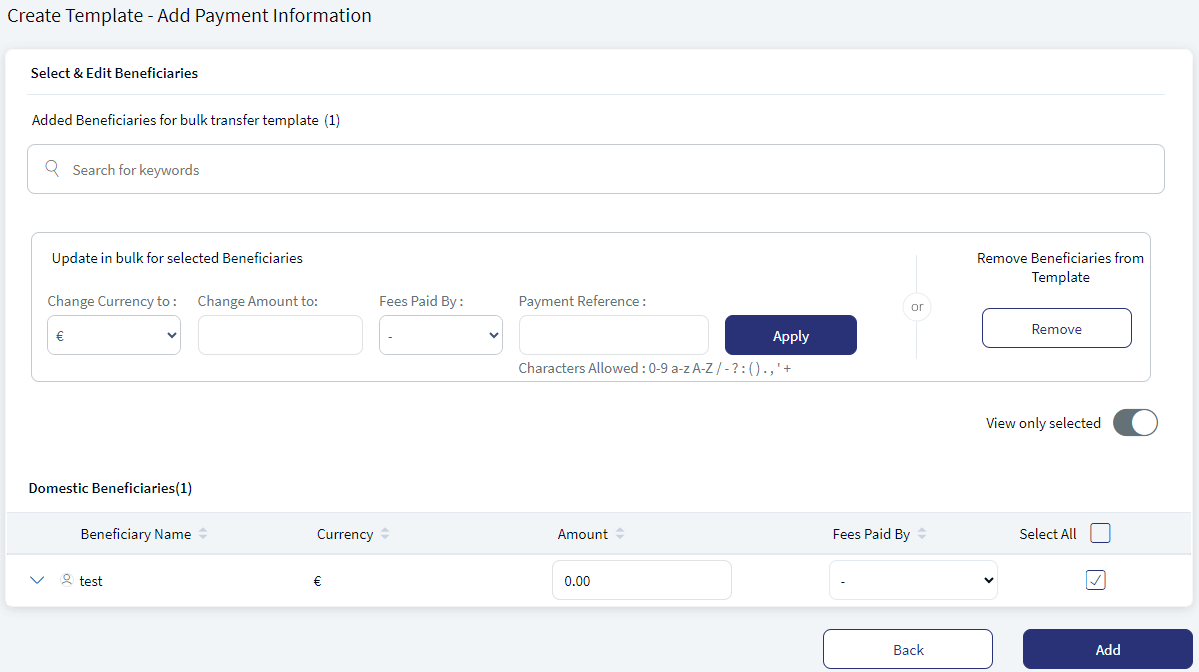
Bulk Payments - Add Payment Information - The application displays the list of segregated beneficiary details in Accounts in same bank and Accounts in another bank (domestic and international) with the following details: Beneficiary Name, Currency, Payment Amount, and Fees paid by person. The list is sorted by Beneficiary Name by default, but can also be sorted by Currency, Amount, and Fees Paid by using the sort icon.
- Do any of the following:
- Update the payment information in bulk for selected beneficiaries: Select the check box of the required beneficiaries and update the data in bulk. The following information can be updated:
- Change the currency from the list.
- Enter the changed amount.
- Select the person who will bear the fees. logged-in user, beneficiary, or shared.
- Enter the Payment Reference notes. It denotes the beneficiary reference details.
Only 0-9 a-z A-Z / - ? : ( ) . , ' + characters allowed are enter the field.
- Click Apply Changes. The data of the selected beneficiaries is updated.
- Use the search bar to search for specific beneficiaries.
- Remove beneficiaries from the template. Select the check box of the required beneficiaries to be removed and click Remove.
- Update the payment information in bulk for selected beneficiaries: Select the check box of the required beneficiaries and update the data in bulk. The following information can be updated:
- Click Add to add the selected beneficiaries to the template.
- The application displays an acknowledgment that the beneficiary is added to the template successfully.
- Click Select from Existing Beneficiaries.
- Add New Beneficiary. Add beneficiaries manually to the template. All fields are mandatory until otherwise stated. Follow these steps:
- On the add beneficiaries screen, click Add New Beneficiary. The user is provided with two options. Add a beneficiary account that resides in the same bank or add a beneficiary that resides in another bank.
- Select the beneficiary's account. Account in same bank or Account in another bank. The fields vary depending on selected bank.
- Account in same bank
- Enter the Beneficiary Account Number or IBAN. The application verifies the account number with the backend system and displays an appropriate message if the account number is wrong.
- If the Processing Mode is Single, the Currency is the default currency selected on the primary details screen and cannot be changed. If the Processing Mode is Multiple, you can define the payment currency.
- Enter the payment Amount.
- Enter the Beneficiary Name.
- Enter the Payment Reference details.
Only 0-9 a-z A-Z / - ? : ( ) . , ' + characters allowed to enter in the field.
- Select the check box Add this beneficiary to existing beneficiary list to add to the list of registered beneficiaries. This step is optional.
- Account in another bank. For External bank, the user can define if it is a Domestic payment or International Payment.
- Select the Account Type - Domestic or International.
- Enter the Beneficiary Account Number or IBAN.
- Enter the SWIFT / BIC number. It denotes the beneficiary bank code details.
- Enter the Beneficiary Bank Name. It denotes the payee account holding bank details.
- If the Processing mode of the template is Single, the Currency is the default currency selected on the primary details screen and cannot be changed. If the Processing mode is Multiple, the user can define the Payment currency.
- Enter the Amount.
- Enter the Beneficiary Name or payment receiver.
- Select who will bear the Payment Transaction Fees - Me, Beneficiary, or Shared.
This field is not applicable if same bank option is chosen.
- Me. The payer (sender of the payment) will bear all of the payment transaction fees.
- Beneficiary. The payee (recipient of the payment) will incur all of the payment transaction fees.
- Shared. The payer (sender of the payment) will pay all fees charged by the sending bank. The payee (recipient of the payment) will pay all fees charged by the receiving bank.
- Enter the Payment Reference details. It denotes the beneficiary reference details.
Only 0-9 a-z A-Z / - ? : ( ) . , ' + characters allowed to enter in the field.
- Select the check box Add this beneficiary to existing beneficiary list to add to the list of registered beneficiaries. This step is optional.
- Account in same bank
- After entering all the required information, click Add.
When the processing mode is selected as Single / Multiple, the user can add beneficiary having same bank account, domestic account, and international account.
- The application displays an acknowledgment that the beneficiary is added successfully.
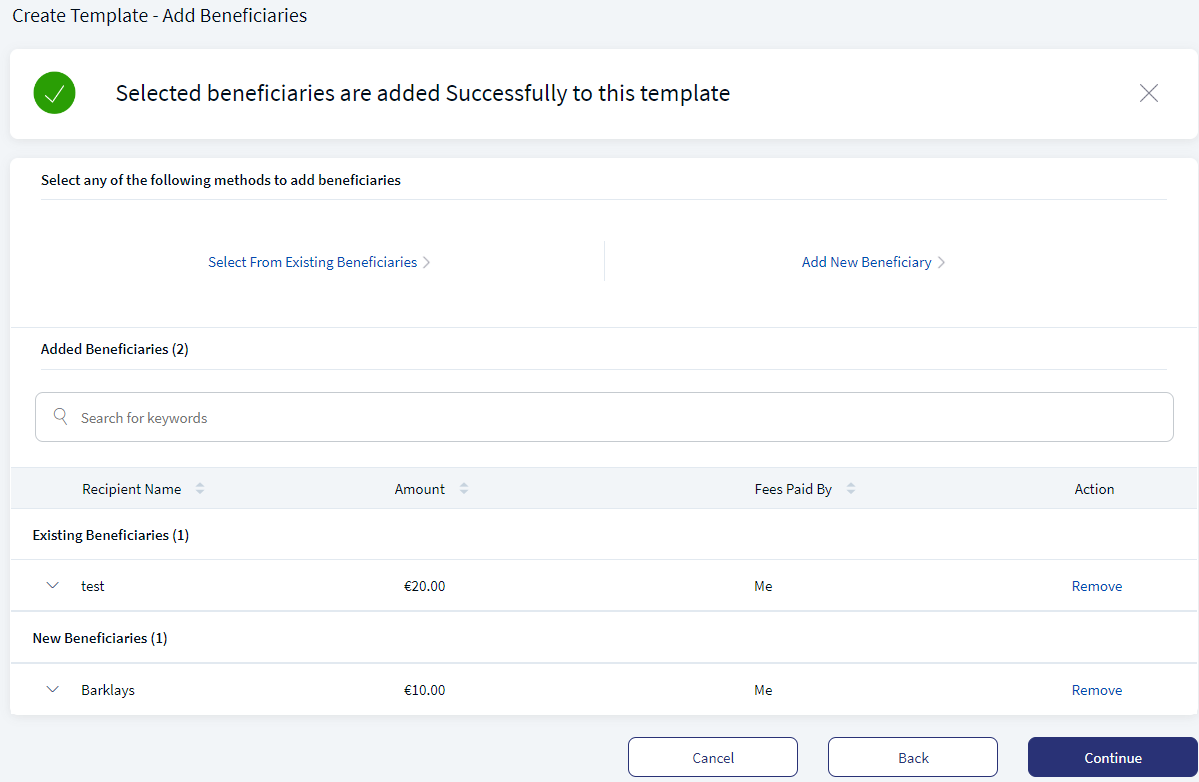
Bulk Payments - Click Continue to proceed to verify and create template screen.
- On the add beneficiaries screen, click Add New Beneficiary. The user is provided with two options. Add a beneficiary account that resides in the same bank or add a beneficiary that resides in another bank.
- Verify and Create Template
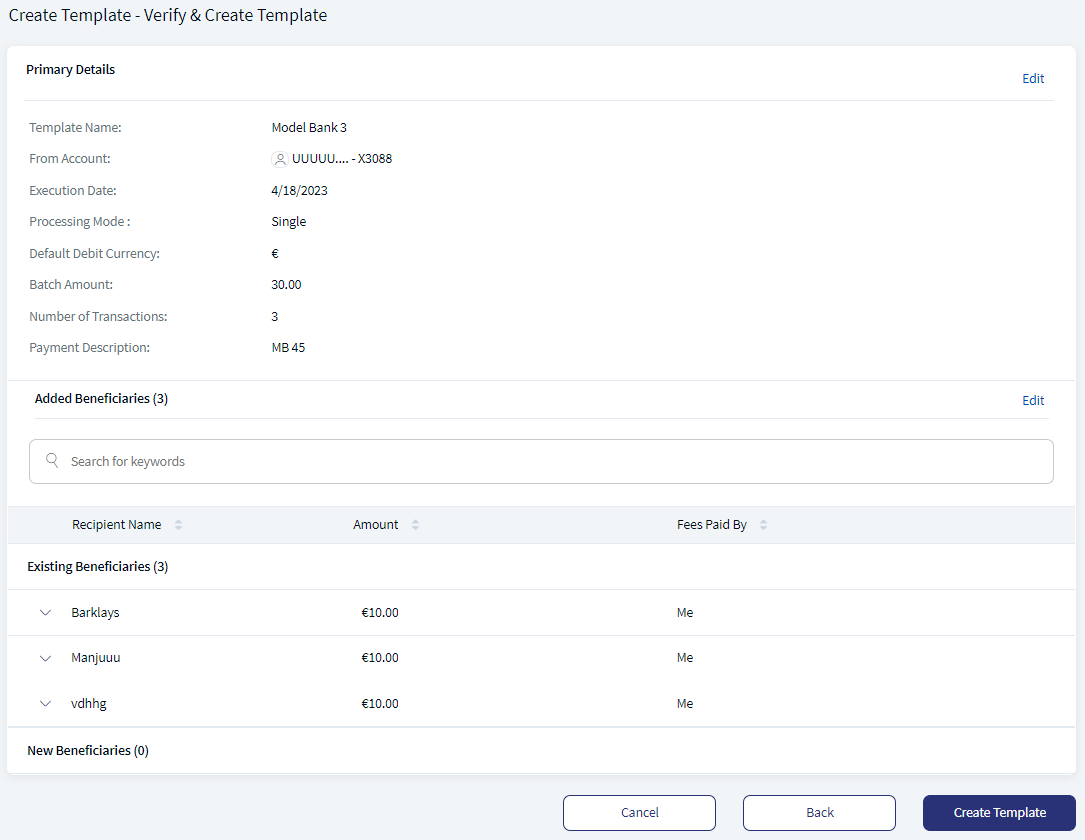
Verify and Create Template
- On the verify template screen, verify the information and make changes as required.
- Click the Edit link to modify the Primary Details and Added Beneficiaries sections.
- Search for the recipients using the search bar.
- Sort the beneficiaries list using the sort icon.
- Click the down arrow to view the beneficiary details.
- After making the changes, click Create Template. The template is created, and the application displays an acknowledgment screen.
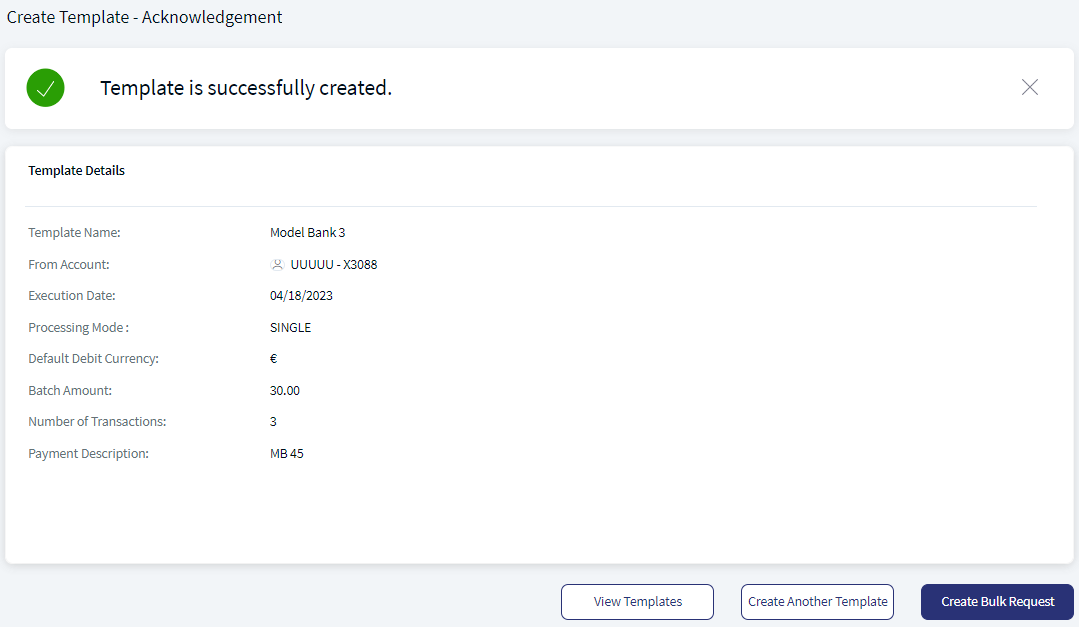
Create Template - Acknowledgement - Acknowledgment.
- After the template is successfully created, the application displays an acknowledgment screen with the following details: Template Name, From Account, Execution Date, Processing Mode, Total Amount with Currency Code, Number of Transactions, and Payment Description.
- Do any of the following:
- Click Create Bulk Request to carry out a bulk payment request with this template.
- Click View Templates to navigate to the list of templates.
- Click Create Another Template to create another template again.
Click Back to go the previous screen or click Cancel to cancel the process at any time. The changes are not saved.
Upload File and Make Payment
Use the feature to initiate a bulk payments transaction by uploading an XML or a CSV file that has the details of multiple payments.
Web Channel menu path:
- Side menu > Bulk Payments > Upload File
- On the right-side bar > Upload File & Make Bulk Payment
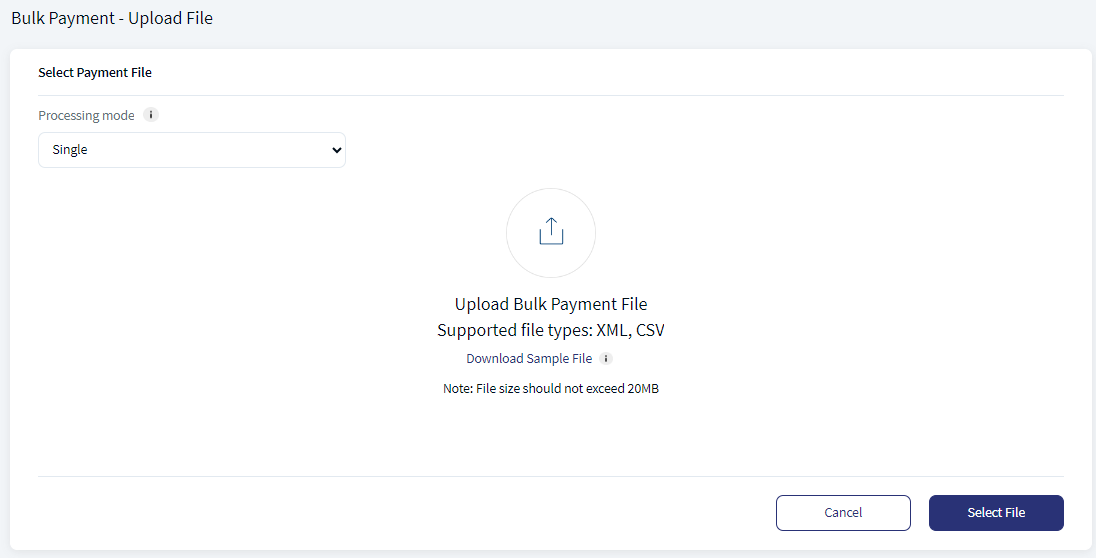
The application displays the screen to upload a bulk payment file. Follow these steps:
- The following file formats are supported: XML and CSV. The file not complying the recommended formats are not uploaded into the processing application.
- CSV file format is a Transact proprietary format.
- XML file format is Pain 001.03 format and Pain 001.001.09 format.
- Click the Download Sample File to download the .csv file generator Excel template. Using this template, the user can generate the .csv file to upload and process the payments. The file size cannot exceed 20 MB.
- Select the Processing Mode from the list. It can be Single or Multiple.
- Click Select File and locate the file to be uploaded.
- The application displays the screen to check the upload file details.
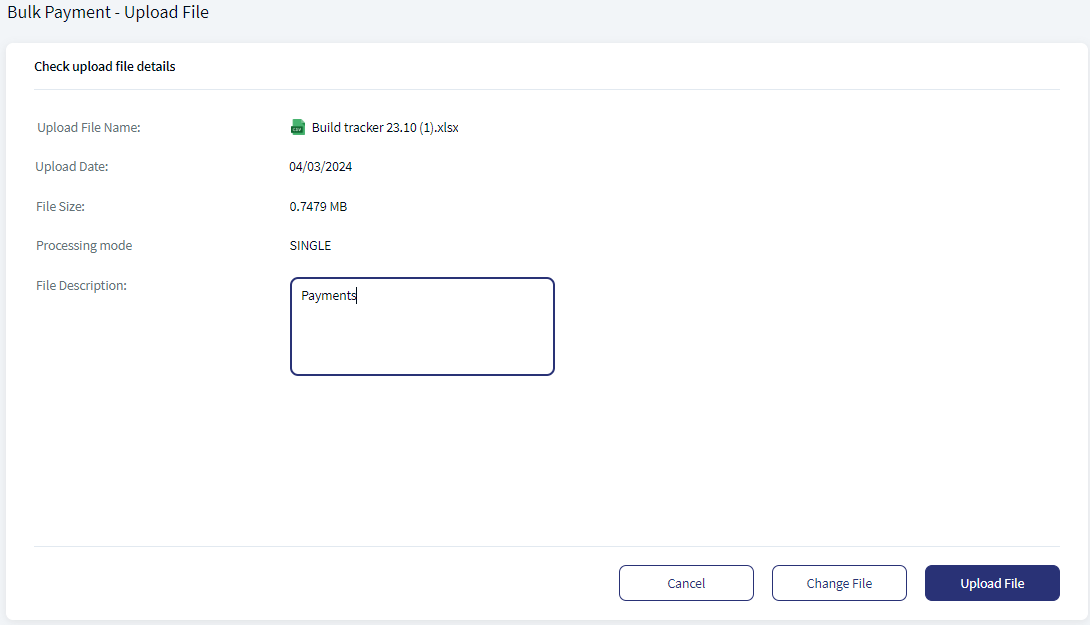
Bulk Update - Upload File - Enter the File Description not exceeding 50 characters.
Click Change File to select another file to upload or click Cancel to cancel the operation. The changes are not saved.
- Click Upload File.
- The application parses the file and if no errors are encountered, then displays a message that the upload is successful. The file is added to the list of already upload status for reference.
The application displays an error message if the file has data errors or any of the following error occurs during file upload resulting in the upload not being successful. The user must fix the error first and then only can upload the file.
- Incorrect file format
- Incorrect debit account
- Incorrect execution date
- Incorrect processing mode
- Insufficient permissions
- Do any of the following:
- Click Upload New File to add or upload another file.
- Click Back to Upload Files to navigate to the list of uploaded files.
Upload Status
Use the feature to view the list of uploaded files (to create requests) and track the status of the uploaded files.
Web Channel menu path: Side menu > Bulk Payments > Upload Status
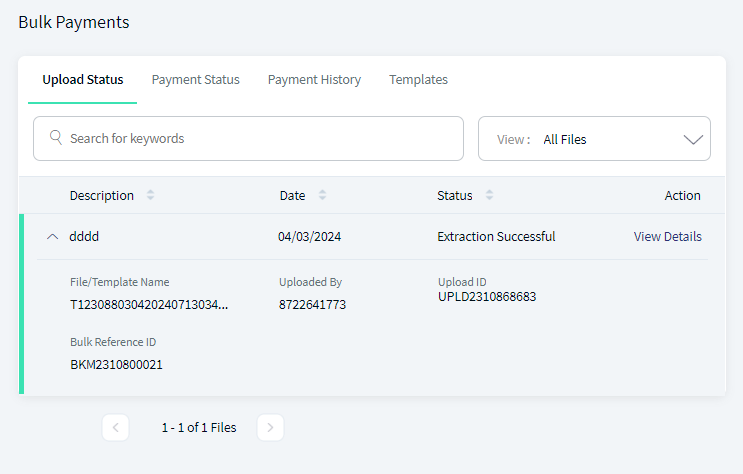
The application displays the list of uploaded requests with Description, Date uploaded, Status, and Action. The following status are displayed:
| Upload Status | Action |
|---|---|
| Uploaded | No action |
| Extracting Payments | View Details |
| Extraction Successful | View Details |
| Extraction Failed | Upload again |
Uploaded. The status indicates that the file is uploaded and is pending to be read and extracted by the system. If you select View Payment while the extraction is still in progress the following error message is displayed as Extraction is still under process, please view after sometime with OK button to revert to Upload tab.
Extracting Payments. After the file has been uploaded into the processing application and the details are extracted. If you select View Payment while the extraction is still in progress the following error message is displayed as Extraction is still under process, please view after sometime with OK button to revert to Upload tab.
Extraction Successful. This indicates the payment details are extracted and the request has been created in the processing application which needs to be reviewed and submitted for processing by the user.
- If you click View Details after the extraction is successful, the application redirects to Payment Status tab with the expanded view of the Bulk File Reference ID.
- If you click View Details after the extraction is successful and the bulk file in Completed status, the application redirects to Payment History tab with the expanded view of Bulk File Reference ID.
Extraction Failed. The file is not processed due to incorrect values or validation failure.
If you click Upload with the file status as "Extraction Failed", the application redirects to Upload File tab to the upload the file again.
Do any of the following:
- Use the down arrow to view the following details: File Name, Description, Uploaded Date, Request Status (processed), Upload ID, Uploaded by, and Bulk Reference ID.
- Use the search bar to look for specific payment requests using the Upload Reference ID, File Name, and Description.
- only single upload CSV, single upload XML can create and view bulk request with single mode.
- only multi-upload CSV, multi-upload XML can create and view bulk request with multi-mode.
- both single and multi-upload CSV, single and multi-upload XML can create and view bulk request with single and multi-mode.
Payment Status
Use the feature to view the list of requests for review and take actions such as review and submit the request details, download, print, or cancel the bulk payment request.
Web Channel menu path: Side menu > Bulk Payments > Payment Status
Do any of the following:
- Use the down arrow to view the following details: From Account, Total Amount, Initiated By, Bulk Reference ID, total transactions, error description, and if applicable the reason for rejection or cancellation.
- Use the search bar to look for specific payments.
- Use the View list to filter the requests by their status and applicable actions. By default, all requests are displayed:
- Ready for Review. Indicates the request has been created in the processing application and it is ready to be reviewed and submitted for approval or execution. A user can Review Request or View Request (if permission is only View).
- Pending for Approval. The request has been submitted for approval and it is pending for authorization. The uploaded user can only view the request.
- Rejected by Approver. The request has been rejected by the approver. The uploaded user can review request or view request (if permission is only View). The user having review permission can either re-submit the request for approval or cancel the request.
- Cancelled. The request has been canceled by the initiator. The user can only view the request.
- Processing Payments. The request has been approved by the approver and the processing application has started processing the request.
- Scheduled. The request has been submitted for future date and the user can cancel the request, if required. The file will be moved to Cancelled, once Cancel function is executed.
- Click Review Payment to take further action on the specific request to view the details and submit for executing or canceling the bulk payment request.
- only single upload CSV, single upload XML can view payment status with single mode.
- only multi-upload CSV, multi-upload XML can view payment status with multi-mode.
- both single and multi-upload CSV, single and multi-upload XML can view payment status with single and multi-mode.
Review and Submit Payment Request
Use the feature to review and submit the request details or cancel the bulk payment request.
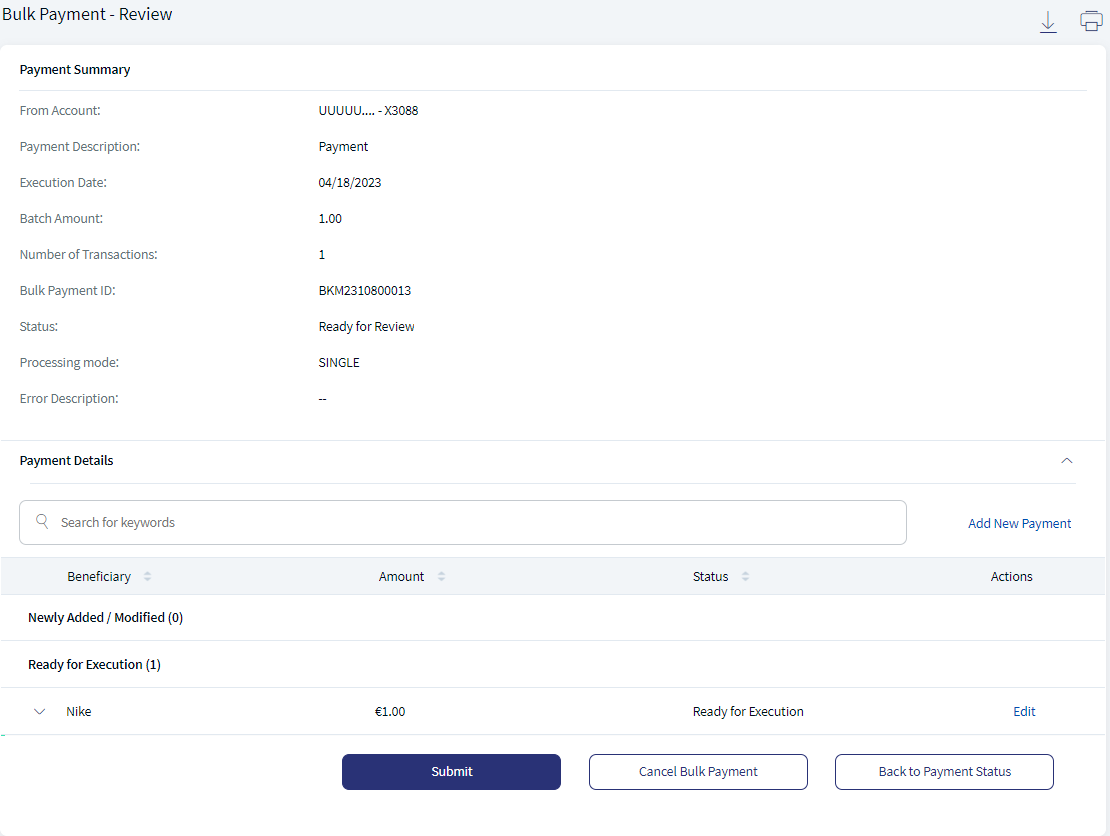
Do any of the following:
- Back to Payment Status. Click to go back to the payment requests list.
- Cancel Bulk Payment. Click to cancel the bulk payment.
- On the confirmation pop-up that appears, select a reason from the Cancellation Reason list.
- Enter comments.
- Click Yes to confirm.
- The status of the request is changed to "Canceled" and moves to view payment mode.
You can cancel a future dated scheduled bulk payment.
Review Payment. Click Review Payment on the Payment Status tab. The application displays the request with the following details for review:
- Payment Summary details with From Account, Payment Description, Execution Date, Total Amount, Number of Transactions, Bulk Payment ID, Status, Processing Mode, and Error Description.
- Payments Details with Beneficiary Name, Amount, and the Payment Status.
- Use the search bar to look for specific payments.
- After review, click Submit.
User is restricted from submitting the request if any of the payment orders are in error state in the Payment Details list. The application restricts the user from submitting and does not allow for execution or for approval.
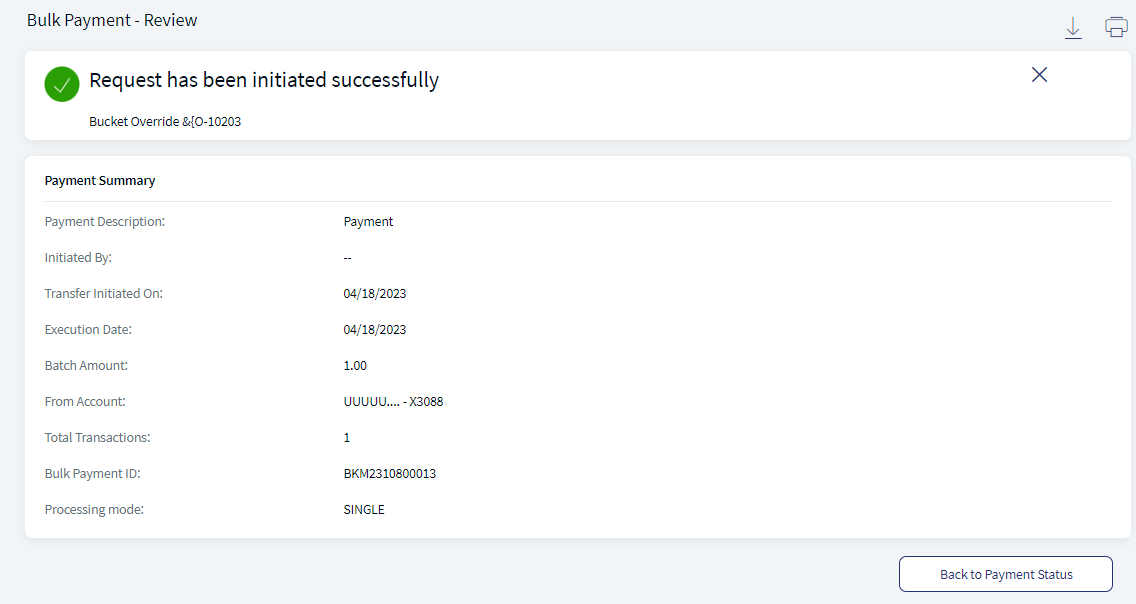
Bulk Payments - Review - The application displays an acknowledgment screen. Click Back to Payment Status list to go back to the list.
- If the user has sufficient permissions for execution, then the payment request is initiated for execution. Otherwise, the request is submitted for approval.
- The approvers can approve and initiate the payment request. Once the request is approved, the request goes for processing and until all payments are processed, the request is listed on the Payment Status tab. See approvals and approval matrix for more information.
- When the request is approved and initiated for payments, the request status will be Processing Payment and listed on the Payment Status tab.
- After the payments are processed and completed, the request status is updated to Completed and listed on the Payment History tab.
- If the user has
- only single upload CSV, single upload XML can review and submit payment request with single mode.
- only multi-upload CSV, multi-upload XML can review and submit payment request with multi-mode.
- both single and multi-upload CSV, single and multi-upload XML can review and submit payment request with single and multi-mode.
Payment History
Use the feature to view the list of processed or executed payment requests.
Web Channel menu path: Side menu > Bulk Payments > Payment History
Do any of the following:
- Use the down arrow to view the following details: Request File Description, Uploaded Date, Total Amount, From Account, Total Transactions, Payment ID, Payment Initiated By, Number of Approvals as approval status, and Payment Status (executed).
- Use the search bar to look for specific requests.
- Under Actions, click Back to Payment History to view the processed payment request details.
- only single upload CSV, single upload XML can view payment history with single mode.
- only multi-upload CSV, multi-upload XML can view payment history with multi-mode.
- both single and multi-upload CSV, single and multi-upload XML can view payment history with single and multi-mode.
Templates
Use the feature to view the list of bulk payment templates that have already been created.
If no templates are found, the application displays an appropriate message.
Web Channel menu path: Side menu > Bulk Payments > Templates
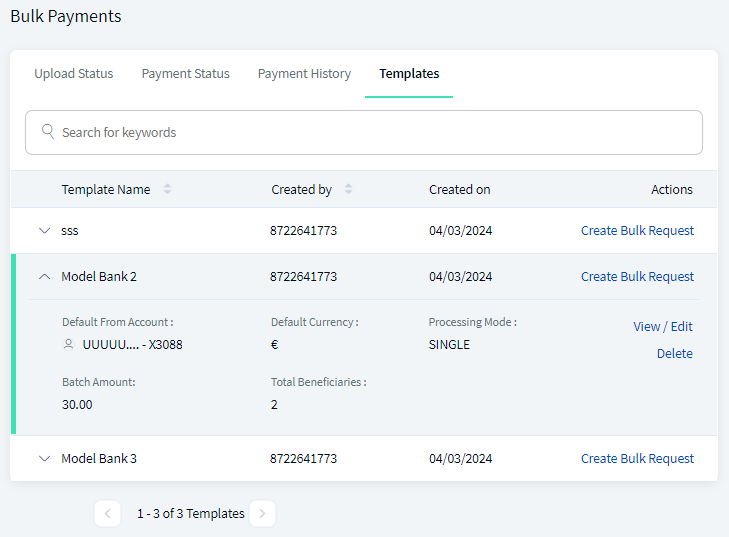
The list is sorted by Template Name by default, but you can also sort the list based on Created by column using the sort  icon.
icon.
Do any of the following:
- Search for a template by using search keywords.
- Click the down arrow to do the following:
- View the template details such as the template name, template created by, created on date, default from account, default currency, processing mode (single or multiple) total amount, and total beneficiaries in the template.
- Click View / Edit to view or edit the template details.
- Click Delete to remove the template if it is no longer required.
- Click Create Bulk Request to initiate a bulk payment request.
- only single upload CSV, single upload XML can view templates with single mode.
- only multi-upload CSV, multi-upload XML can view templates with multi-mode.
- both single and multi-upload CSV, single and multi-upload XML can view templates with single and multi-mode.
View / Edit Template Details
The user have option to view and edit the past dated template and initiate the bulk request with current or future date from existing template. Use the feature to edit the template details.
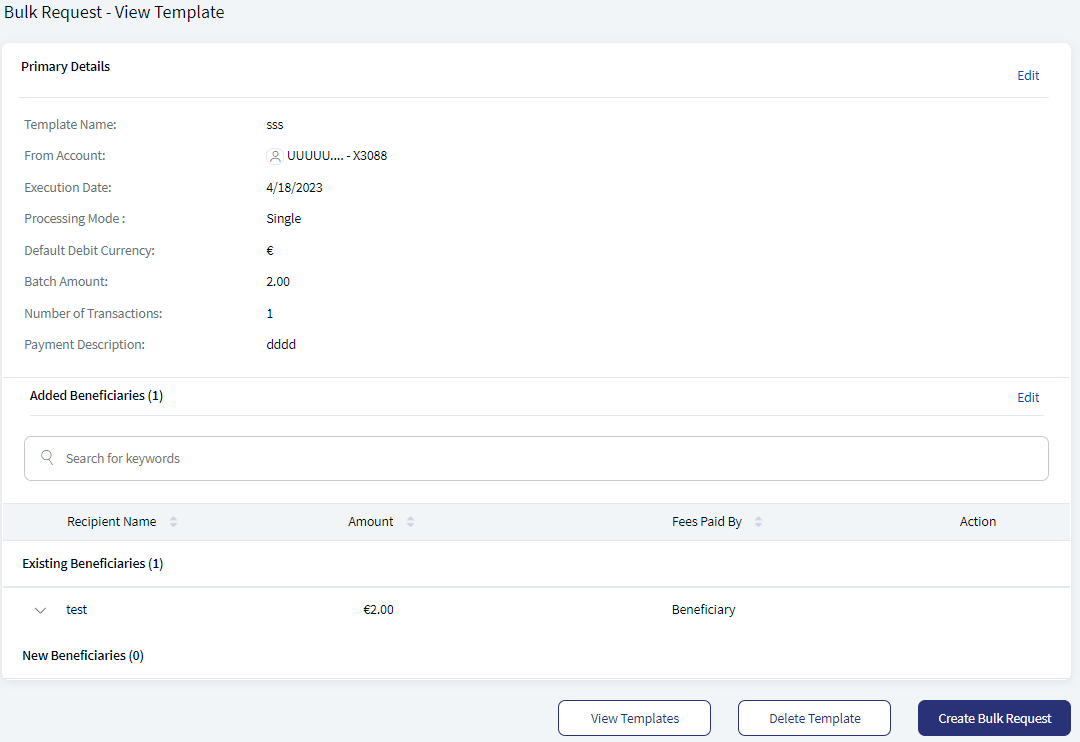
Do any of the following:
- Edit Primary Details.
- Click Edit to modify the details as required. In the Edit Template. Primary Details page the user can edit Template Name, Select Default From Account, Default Debit Currency (Updates automatically as per the Default From Account), Processing Mode, Execution Date, short Description.
- Click Save & Update. The changes are updated.
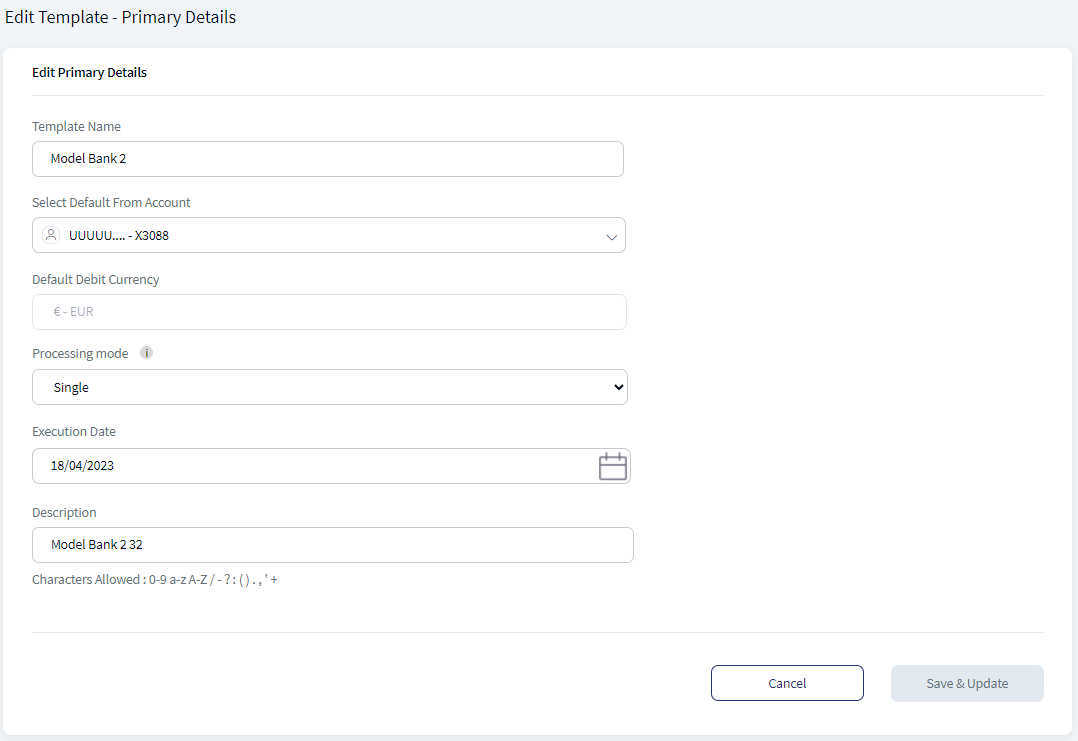
Bulk Payments - Edit Template
- Edit Added Beneficiaries
Click Edit to edit the Added Beneficiaries list.
Do any of the following in Edit Template - Select Beneficiaries page.- Add new beneficiaries from any of the two options Select From Existing Beneficiaries or Add New Beneficiary.
- Remove Existing Beneficiaries. Click Remove to delete the beneficiaries as required.
- You can also edit the payment details. Expand the Existing beneficiary by clicking the down arrow.
- Click Edit. This navigates to Edit Template - Add Beneficiary page.
- The user can edit Beneficiary Account Number / IBAN, Currency, Amount, Beneficiary Name, Payment Reference.
- Click Save & Update to update the details.
- Click Back to discard the changes and go to previous page.
- Click Continue. The changes are updated.
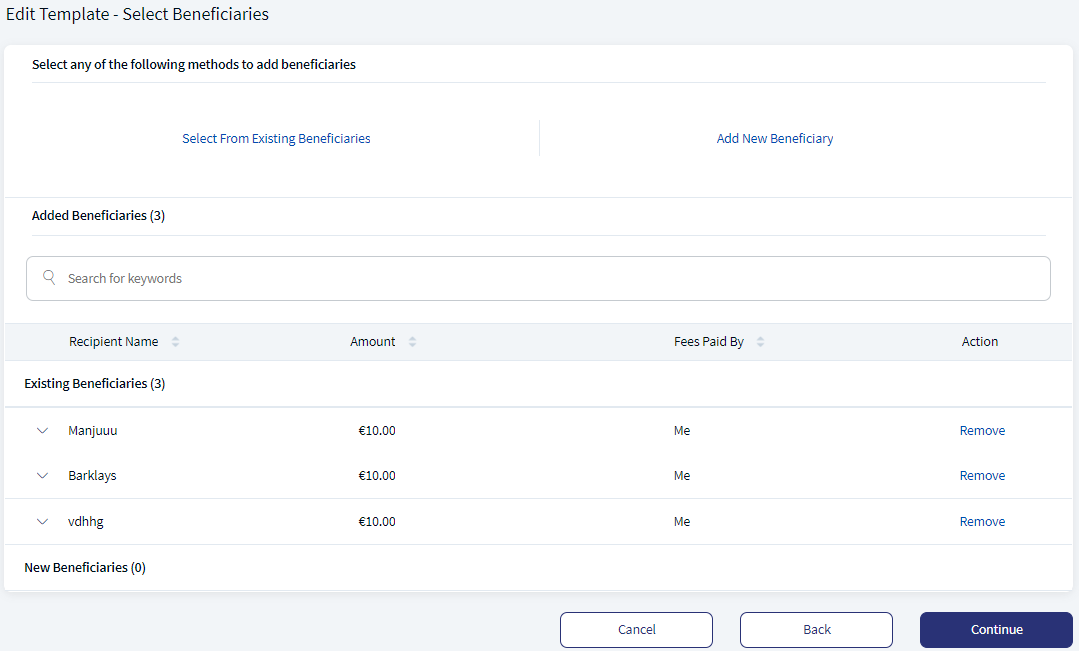
Bulk Payments - Edit Template - Select Beneficiaries
- Click View Templates to go back to the templates list.
- Click Delete Template to remove the template if it is no longer required. On the pop-up that appears, click Yes to confirm.
- Click Create Bulk Request to initiate a bulk payment request.
If the user has made changes in the template, click Continue after the changes and the application displays an acknowledgment screen that the details are updated successfully.
Delete Template Details
The user has option to delete any past dated existing templates. Use this feature to delete the template if it is no longer required.
- Click Delete from the expanded template details to remove the template if it is no longer required. On the pop-up that appears, click Yes to confirm.
- Click Delete Template from the Bulk Request - View Details page to remove the template if it is no longer required. On the pop-up that appears, click Yes to confirm.
Create Bulk Request
Use the feature to execute a bulk payment request using an already created template so that multiple payment details are uploaded by the user and the payments are initiated in a single instance.
Web Channel menu path: Side menu > Templates tab> Create Bulk Request link
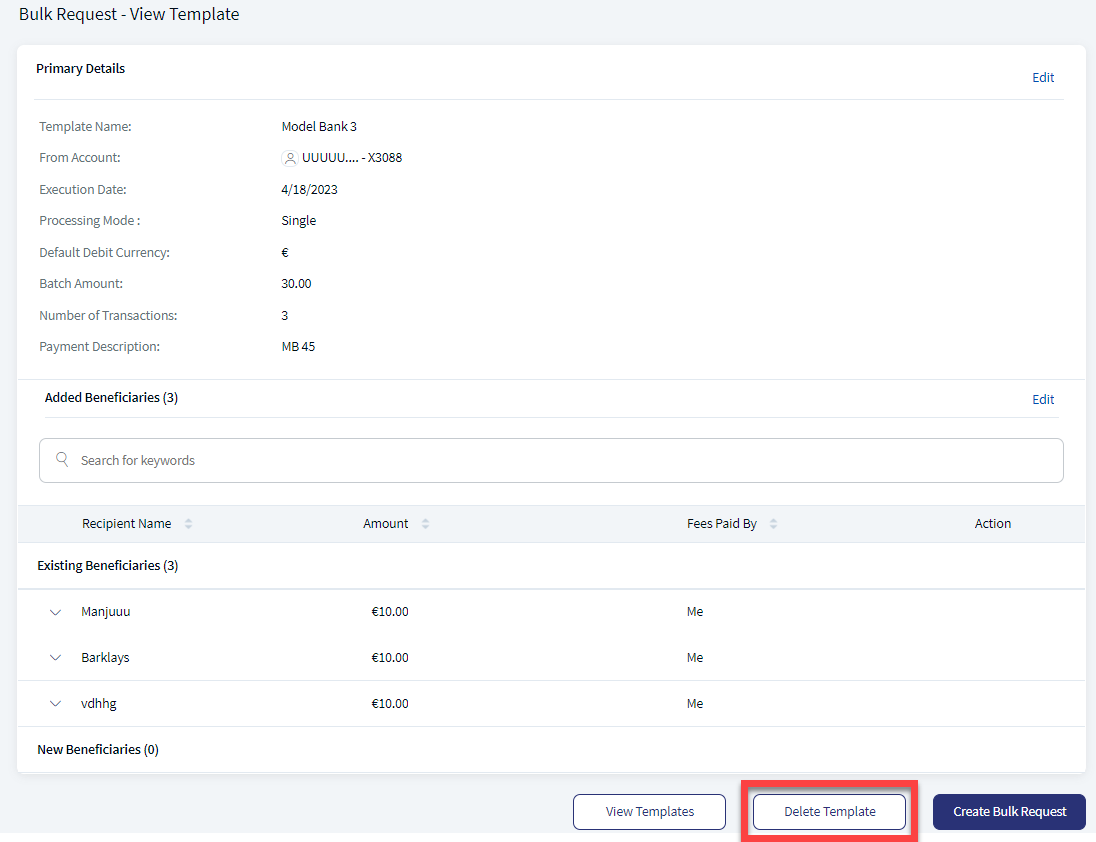
To create a bulk payment request, follow these steps:
- On the Templates tab, from the list of templates, click the Create Bulk Request link of the template using which, the bulk payment request is made. The templates should have already been created. See Create New Template for more information.
- The application displays the Create Bulk Request - Verify & Confirm screen.
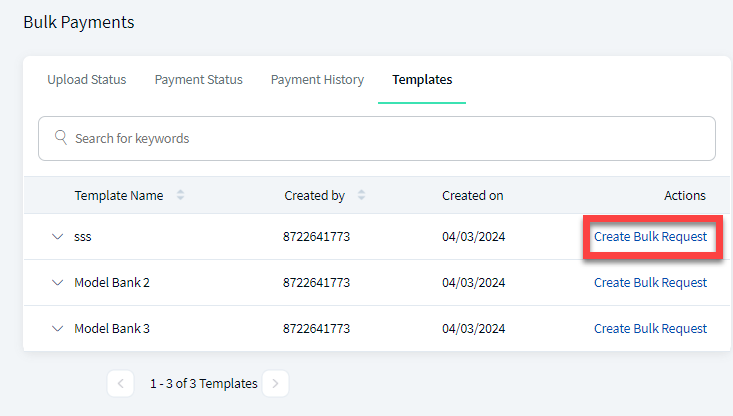
Bulk Payments - Create Bulk Payment - The application displays the following:
- The template name and the number of beneficiaries on top of the screen.
- List of segregated beneficiary details such as Account in same bank and Account in another bank with the following details: Beneficiary Name, Currency, Amount, and Fees Paid by Person. The list is sorted by Beneficiary Name by default, but can also be sorted by currency, amount, and fees paid by using the sort
 icon.
icon.
- Select the Execution Date to current or upcoming date.
- Verify the details before confirming the payment. Do any of the following:
- Use the search bar to search for specific beneficiaries.
- Update in bulk for selected beneficiaries: Select the check box of the required beneficiaries and update the data in bulk. The following information can be updated:
- Enter the changed amount.
- Enter the Payment Reference.
Only 0-9 a-z A-Z / - ? : ( ) . , ' + characters allowed to enter in the field.
- Click Apply Changes. The data of the selected beneficiaries is updated.
- Click the View only selected toggle button to display only the selected beneficiaries.
- Change the currency (applicable only if the processing mode is Multiple) and payment amount of individual beneficiaries.
- Remove beneficiaries from bulk payment request.
- Select the check box of the required beneficiaries to be removed.
- Click Remove.
- View All Removed Beneficiaries. When editing an existing template and removing beneficiaries, the user can view the list of remove beneficiary and add it back if needed.
- After all updates are made on the Payment Details screen, click Continue to save the details and go to Verify & Confirm screen.
- After verifying the details, click Create and Upload Request.
- If the request is initiated successfully, the application displays an acknowledgment screen summarizing the transaction details.
- Do any one of the following:
- Click Create Another Request to carry out another bulk payment request with the same template.
- Click View Templates to navigate to the list of templates.
- Click View Upload Status to navigate to the list of uploaded files to view their status.
- An extra validation for the execution date while creating a new Create Bulk Request. The execution date should be a current or upcoming date and not a past date.
- If the user has
- only single upload CSV, single upload XML can view templates with single mode.
- only multi-upload CSV, multi-upload XML can view templates with multi-mode.
- both single and multi-upload CSV, single and multi-upload XML can view templates with single and multi-mode.
File Status Filter
You can filter the requests by their status and applicable actions. By default, all requests are displayed. The following table displays the list of statuses for each tab to filter the records.
| Tab | Filter Options |
|---|---|
| Upload Status |
|
| Payment Status |
|
| Processing Type |
|
| Payment History | Date range |
Error Handling for Bulk Payment Validation Failure
You can handle a bulk request that is created in error state due to a validation failure post upload.
- If the bulk payment record initiated is displayed in the Payment Status dashboard with error description, you must cancel the request and upload a new file as the error is not amendable.
- If the bulk payment file uploaded has multiple erroneous payment, the error message is displayed along with the payment. You can either modify the error of that payment, remove the payment in error or cancel the bulk payment request.
Beneficiary Management
A user can have access to multiple contracts and a contract can have single or multiple Customer IDs within it. Also, a contract can be a combination of single or multiple retail and business customer IDs. The beneficiaries are stored/associated at a customer ID level and all the actions of view, edit, and delete a beneficiary is controlled by the permissions the user has at the customer ID level. A user can share the beneficiary with other customer IDs (to which the user has permission) or associate with one or multiple customer IDs. In the "Manage Beneficiary" screen, the beneficiaries are listed based on the customer IDs to which the user has access. The beneficiaries are stored in the DBX DB.
A contract can have the following use cases and a user associated with the contract can be classified as:
- Single Retail Customer ID (Retail)
- Multiple Retail Customer IDs (Retail)
- Single Business Customer ID (Business)
- Multiple Business Customer IDs (Business)
- Multiple Retail & Business Customer IDs (Combined)
Key points:
- The beneficiaries created are associated with Customer ID.
- A logged-in user can create/edit a beneficiary only if the user has permission for Create Beneficiary feature action under any of the following: Transfer/Bill Payment/Bulk payment/Domestic and International Wire/P2P.
- If the logged in user has access to more than one Customer ID, the user will have an option to share the beneficiary with one or multiple Customer IDs (to which the user has permission).
- If the user has Edit permission, the user can edit the beneficiary also as stated above.
- In case of Delete, if the user deletes a specific beneficiary, it will be deleted against all the customer IDs linked to it.
- While making a payment, when a user selects a specific account based on the customer ID of the that account in the "To" field, all the beneficiaries are listed.
- The same logic is applied when making payment through "Send Money" option from the Manage Beneficiary screen. This is applicable only for transfers.
- In the "Manage Beneficiary" section, the beneficiaries are listed based on the customer IDs the user has access. Also, if the same beneficiary is available across multiple Customer IDs, the beneficiary appears once on the screen. On clicking the Beneficiary, the number of customer IDs with which it is associated are displayed.
- In addition to the customer ID level access, the beneficiary listing is based on the Feature level permission of the logged-in user.
- If a user tries to add a same beneficiary record which is already associated with that customer ID, the system will do a duplicate check and throw error.
When the user initiates a bulk payment in foreign currency, the user transaction limit and approval limit is verified against the base currency in spotlight.
- The limit setup in Spotlight is EUR as the base currency. If the transfer currency is EUR then no change is required for the transaction.
- If the transfer currency is foreign currency (other than EUR), the transfer currency amount entered by the user as part of payment initiation must be converted into the base currency (EUR) based on rate provided from transact.
- Post conversion, the user limit and approval limits are validated. If the conversion amount into EUR is more than the limit setup in Spotlight, the application displays a limit breach error.
Configuration
The following configurations are applicable for Bulk Payments:
- The visibility of each feature is controlled through the permissions defined for the user.
- This feature is applicable only in online banking application and integrated with (Undefined variable: Product_Names.Infintiy) Transact directly. The request is created in Transact and the Transact application processes the payments.
- Depending on the bank configuration, if Strong Customer Authentication(SCA) is enabled for the feature, SCA is triggered. The authentication type is configured and can be turned on or off in the Spotlight application. See Push Notifications for more information.
Backend Integration - Transact/MS/Mock
Using the runtime configurable parameter (Bulkpayment_Backend server property) at the Micro App level, an implementation team can configure the backend integration endpoint as Transact, or Mock as per customer needs for the following. The BulkPayments Fabric MA supports the integration.
- The backend integration for all the APIs is mocked (DBX DB) or SRMS based on customer needs.
- The validations are avoided if the module is directly integrated with Transact endpoints.
- When records are created, use these options: Use the DBX DB table records that already exist, or use the Fabric Java layer to build a stubbed or JSON data response directly.
Follow these steps:
- Sign-in to your Fabric console.
- From the left pane, select Environments.
- For your Fabric run-time environment, click App Services.
- Navigate to Settings > Configurable Parameters.
- On the Server Properties tab, go to
BULKPAYMENT_BACKENDField Name and set the Field Value depending on the integration (for example, MOCK).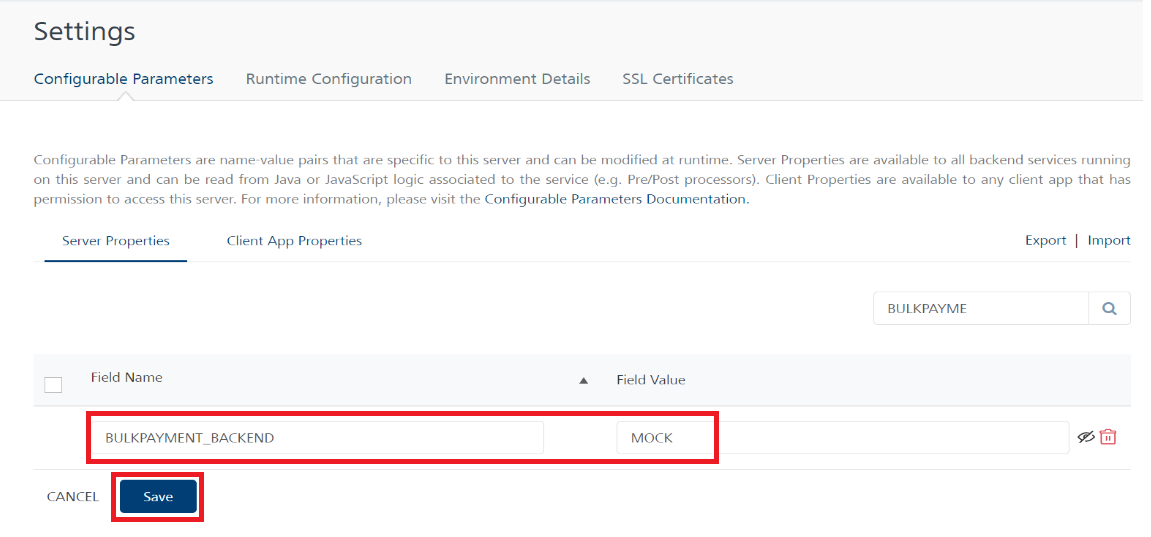
- Click Save.
APIs
The following APIs are shipped as part of this feature. For the complete list of APIs shipped as part of this feature, see Experience APIs documentation.
| Name | Description | Introduced In |
|---|---|---|
| UploadFile | This API uploads the Bulk Payment File. | 2020.10 |
| fetchUploadedFiles | This API retrieves the uploaded files. | 2020.10 |
| fetchOnGoingPayments | This API retrieves the list of ongoing payments. | 2020.10 |
| fetchHistory | This API retrieves the history of Bulk Payments. | 2020.10 |
| review | This API reviews the records. | 2020.10 |
| fetchRecordsWaitingForMyApproval | Retrieves the records that are in waiting for approval. | 2020.10 |
| fetchRecordsReviewedByMeAndInApprovalQueue | Retrieves the records that are reviewed and are in the approval queue. | 2020.10 |
| fetchRecordsHistoryActedByMe | Retrieves the history of Bulk Payments that have been executed out by the user. All the records that have been approved or rejected will be fetched. | 2020.10 |
| fetchRecordsHistoryReviewedByMe | Retrieves the history of Bulk Payments that have been reviewed by the user. | 2020.10 |
| approveBulkPaymentRecord | Approves the Bulk Payments record. | 2020.10 |
| rejectBulkPaymentRecord | Rejects the Bulk Payments record. | 2020.10 |
| cancelBulkPaymentRecord | Cancels the Bulk Payments record. | 2020.10 |
| updateBulkPaymentRecord | Updates the Bulk Payments record. | 2020.10 |
| addPaymentOrder | Creates a Payment order. | 2020.10 |
| editPaymentOrder | Edits the Payment order. | 2020.10 |
| deletePaymentOrder | Deletes the Payment order. | 2020.10 |
| fetchSampleFiles | Retrieves the sample Bulk Payment files. | 2020.10 |
| fetchPaymentOrders | Retrieves the payment orders. | 2020.10 |
| createBulkPaymentTemplate | This API creates a bulk payment template. | 2021.01 |
| deleteBulkPaymentTemplate | This API deletes the bulk payment template based on the template ID provided by the user. | 2021.01 |
| fetchBulkPaymentTemplates | This API retrieves bulk payment templates. | 2021.01 |
| initiateDownloadBulkPaymentAck | Initiates the bulk payment acknowledgment file download process. The acknowledgment file is generated after the payment is successfully completed. | 2021.01 |
| downloadBulkPaymentFileAck | Downloads the bulk payment acknowledgment PDF file. | 2021.01 |
| fetchBulkPaymentTemplatePOsById | This API fetches the bulk payment template of payment orders based on the template ID. | 2021.01 |
| editBulkPaymentTemplate | This API edits a bulk payment template. | 2021.01 |
| createBulkRequest | Creates a bulk payment request from the template. | 2021.01 |
| fetchBulkPaymentTemplateById | This API retrieves the bulk payment template details from the based on the template ID. | 2021.01 |
| fetchCancellationReasons | This API retrieves the cancellation reasons for bulk payments. | 2021.10 |
| fetchBulkPaymentRecordDetailsById | This API retrieves bulk payment record based on ID. | 2021.10 |
In this topic
